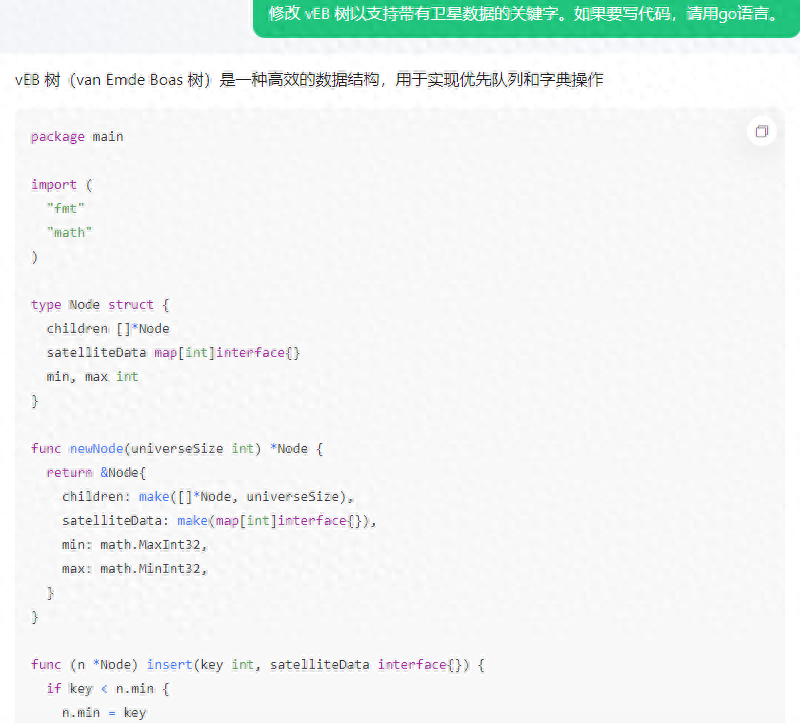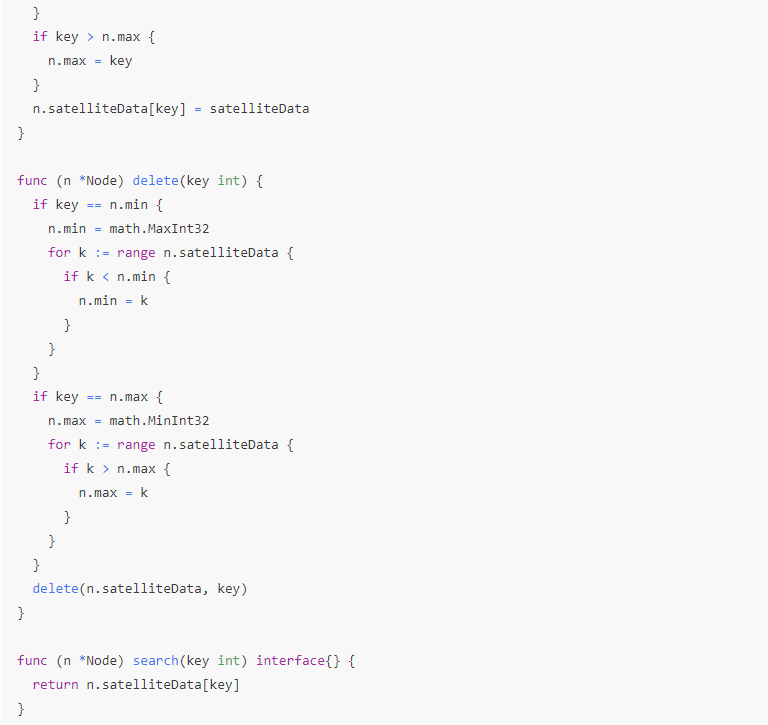二、修改 vEB 树以支持带有卫星数据的关键字。如果要写代码,请用go语言。
文心一言:
vEB 树(van Emde Boas 树)是一种用于处理稀疏位集合的高效数据结构,它允许在常数时间内执行查找、插入、删除和前驱/后继操作。然而,标准的 vEB 树并不直接支持带有卫星数据的关键字。要支持带有卫星数据的关键字,我们需要在 vEB 树的基础上做一些修改。
在 Go 语言中,我们可以定义一个结构体来表示带有卫星数据的关键字,并使用这个结构体作为 vEB 树中的元素。以下是一个简化的 vEB 树实现,支持带有卫星数据的关键字:
package main
import (
“fmt”
)
// SatelliteData 是与关键字关联的卫星数据
type SatelliteData struct {
// 这里可以定义你需要的任何数据
Value int
}
// KeyWithSatellite 是带有卫星数据的关键字
type KeyWithSatellite struct {
Key int
Data SatelliteData
}
// vEBTree 是带有卫星数据的 vEB 树
type vEBTree struct {
universe int // 关键字范围的上限
tree map[int]*vEBTree
data map[int]KeyWithSatellite
}
// NewVEBTree 创建一个新的 vEB 树
func NewVEBTree(universe int) *vEBTree {
if universe <= 2 {
return &vEBTree{
universe: universe,
data: make(map[int]KeyWithSatellite),
}
}
return &vEBTree{
universe: universe,
tree: make(map[int]*vEBTree),
data: make(map[int]KeyWithSatellite),
}
}
// Insert 插入带有卫星数据的关键字
func (t *vEBTree) Insert(key int, data SatelliteData) {
if key < 0 || key >= t.universe {
return
}
if t.universe <= 2 {
t.data[key] = KeyWithSatellite{Key: key, Data: data}
return
}
subTreeIndex := key >> (log2(t.universe) – 1)
subTree, ok := t.tree[subTreeIndex]
if !ok {
subTree = NewVEBTree(t.universe >> 1)
t.tree[subTreeIndex] = subTree
}
subTree.Insert(key-(subTreeIndex*(t.universe>>1)), data)
}
// 这里省略了查找、删除和前驱/后继操作的实现…
// log2 计算以 2 为底的对数(向上取整)
func log2(n int) int {
if n <= 0 {
return 0
}
return int(math.Ceil(math.Log2(float64(n))))
}
func main() {
// 示例用法
universeSize := 16
tree := NewVEBTree(universeSize)
data := SatelliteData{Value: 100}
tree.Insert(5, data)
// … 其他操作 …
}
注意:上述代码是一个简化的示例,用于展示如何在 vEB 树中支持带有卫星数据的关键字。在实际应用中,你可能需要添加更多的错误检查、优化和完整的操作实现(如查找、删除和前驱/后继操作)。此外,由于 Go 语言的标准库中没有直接提供 log2 函数,我使用了 math.Log2 和 math.Ceil 来计算对数并向上取整。你可能需要导入 “math” 包来使用这些函数。
讯飞星火:
vEB 树是一种支持高维度的字典数据结构,它允许在 O(log n) 时间内进行插入、删除和查找操作。然而,vEB 树本身并不直接支持带有卫星数据的关键字。
要修改 vEB 树以支持带有卫星数据的关键字,我们可以将每个节点表示为一个包含两个字段的结构体:一个是关键字,另一个是卫星数据。这样,每个节点就可以存储一个关键字和其对应的卫星数据。
以下是一个简单的示例,展示了如何定义这样的 vEB 树:
package main
import (
“fmt”
)
type SatelliteData struct {
// 在这里添加你的卫星数据字段
}
type Node struct {
Key int
Satellite SatelliteData
Children []*Node
}
func NewNode(key int, satellite SatelliteData) *Node {
return &Node{
Key: key,
Satellite: satellite,
Children: make([]*Node, 0),
}
}
func (n *Node) Insert(key int, satellite SatelliteData) {
if n.Key == key {
n.Satellite = satellite
} else {
for _, child := range n.Children {
child.Insert(key, satellite)
}
}
}
func (n *Node) Find(key int) *SatelliteData {
if n.Key == key {
return &n.Satellite
} else {
for _, child := range n.Children {
result := child.Find(key)
if result != nil {
return result
}
}
}
return nil
}
func main() {
root := NewNode(0, SatelliteData{})
root.Insert(1, SatelliteData{})
root.Insert(2, SatelliteData{})
fmt.Println(root.Find(1))
fmt.Println(root.Find(2))
}
在这个示例中,我们首先定义了一个 SatelliteData 结构体来存储卫星数据。然后,我们定义了一个 Node 结构体,其中包含一个关键字、一个 SatelliteData 和一个子节点列表。我们还定义了 NewNode、Insert 和 Find 方法来创建新节点、插入新节点和查找节点。
360智脑:
在计算机科学中,vEB(Van Emde Boas)树是一种用于集合中关键字的数据结构,它提供了快速查找、插入和删除操作。通常,vEB树不直接与卫星数据相关,但可以被扩展来支持带有附加数据(例如卫星数据)的关键字。
为了在Go语言中实现带有卫星数据的vEB树,我们需要定义一个结构来表示vEB树中的节点,以及一个方法来插入新的关键字和卫星数据。
以下是一个简化的Go语言代码示例,展示了如何为vEB树添加卫星数据:
package main
import (
“fmt”
)
type SatelliteData struct {
// 这里可以添加任意字段以存储与关键字相关的卫星数据
}
type vEBNode struct {
min, max uint64
count int
satData *SatelliteData
}
func (n *vEBNode) insert(key uint64, satData *SatelliteData) {
// 实现插入逻辑
}
func main() {
// 创建根节点
root := &vEBNode{
min: 0,
max: 0,
count: 0,
satData: &SatelliteData{},
}
// 假设我们有一些关键字和卫星数据
keys := []uint64{10, 20, 30, 40}
satelliteDatas := []*SatelliteData{
{ /* some data for key 10 */ },
{ /* some data for key 20 */ },
{ /* some data for key 30 */ },
{ /* some data for key 40 */ },
}
// 插入关键字和卫星数据
for i := range keys {
root.insert(keys[i], satelliteDatas[i])
}
// 现在可以使用root来管理带卫星数据的关键字集合
// …
}
请注意,上面的代码仅提供了一个基本的框架,实际上vEB树的实现会更加复杂,因为它涉及高效的平衡树结构和位运算来优化性能。此外,insert方法需要完成实际的插入逻辑,这取决于您具体的需求和vEB树的具体实现。
如果您正在寻找一个完整的、生产质量的vEB树实现,建议查看现有的软件库或研究更详细的算法资料。vEB树是一种高级数据结构,它的实现既需要对数据结构有深入的理解,也需要良好的编程技巧。
智谱清言:
在计算机科学中,vEB(虚拟扩展二叉)树是一种数据结构,它是一种扩展的B树,可以用于高效地存储和检索大型集合中的元素。在标准的vEB树中,每个节点存储了键的集合,并且每个键都直接映射到子节点的索引。如果要修改vEB树以支持带有卫星数据的关键字,我们可以在每个节点中添加一个额外的数据结构来存储卫星数据。
以下是用Go语言实现的vEB树的基本结构,其中包括了对带有卫星数据的关键字的修改:
package vebtree
import (
“fmt”
)
// Key represents a keyword in the vEB tree.
type Key int
// SatelliteData represents the satellite data associated with a key.
type SatelliteData struct {
// Example fields:
Field1 int
Field2 string
// Add any additional fields for satellite data here.
}
// Node represents a node in the vEB tree.
type Node struct {
Key Key
Satellite SatelliteData
Left, Right *Node
}
// VEBTree represents a vEB tree.
type VEBTree struct {
Root *Node
}
// NewVEBTree creates a new vEB tree.
func NewVEBTree() *VEBTree {
return &VEBTree{
Root: &Node{
Key: Key(0), // Root key can be initialized to 0 or any other value.
Left: nil,
Right: nil,
},
}
}
// Insert inserts a key with associated satellite data into the vEB tree.
func (t *VEBTree) Insert(key Key, satellite SatelliteData) {
// Implementation of the insertion logic would go here.
// This would involve traversing the tree to find the correct position
// for the new key and creating new nodes as necessary.
}
// Search searches for a key in the vEB tree and returns the associated satellite data.
func (t *VEBTree) Search(key Key) (SatelliteData, bool) {
// Implementation of the search logic would go here.
// This would involve traversing the tree to find the key.
}
// Example usage of the vEB tree data structure.
func main() {
tree := NewVEBTree()
// Insert example keys with satellite data.
tree.Insert(Key(1), SatelliteData{Field1: 10, Field2: “Example1”})
tree.Insert(Key(2), SatelliteData{Field1: 20, Field2: “Example2”})
// Search for a key and retrieve the satellite data.
data, found := tree.Search(Key(1))
if found {
fmt.Printf(“Key: %d, Satellite Data: Field1: %d, Field2: %s\n”, data.Key, data.Field1, data.Field2)
} else {
fmt.Println(“Key not found.”)
}
// More operations can be performed here, like deletion, updating, etc.
}
在上述代码中,Node 结构体被设计来存储关键字和相关的卫星数据。VEBTree 结构体保持了树的根节点。Insert 和 Search 方法是基本操作,需要您根据vEB树的性质来实现。这里的main函数提供了一个使用示例。
请注意,为了完整地实现vEB树的所有功能(包括插入、删除、搜索等),需要更多的代码,这取决于树的具体变体和您要支持的操作类型。上述代码只是提供了一个结构和实现这些操作的基本框架。 在实现这些方法时,您需要考虑如何有效地在树中定位关键字,以及如何处理树平衡和节点创建/删除等问题。在处理卫星数据时,也需要考虑数据的一致性和更新策略。
天工:
要修改 Van Emde Boas (vEB) 树以支持带有卫星数据的关键字,我们需要对原始的 vEB 树结构进行扩展。在标准的 vEB 树中,我们只存储整数键,而在扩展版本中,我们将允许每个键关联一个额外的卫星数据。
首先,我们需要定义一个新的数据结构来存储卫星数据。假设卫星数据是一个简单的整数,我们可以创建一个包含键和卫星数据的结构体。然后,我们将这个结构体用于 vEB 树中的节点。
下面是一个简化的 Go 语言实现,展示了如何修改 vEB 树以支持带有卫星数据的关键字:
type SatelliteData struct {
Key int
Data int // 假设卫星数据是一个整数
}
type vEBNode struct {
Min *SatelliteData
Max *SatelliteData
Summary *vEBNode
Cluster []*vEBNode
Size uint64
}
func NewVEB(size uint64) *vEBNode {
return &vEBNode{
Size: size,
}
}
func (v *vEBNode) Insert(key int, data int) {
if v.Min == nil {
v.Min = &SatelliteData{Key: key, Data: data}
v.Max = v.Min
} else {
if key < v.Min.Key {
v.Min, v.Max = &SatelliteData{Key: key, Data: data}, v.Min
} else if key > v.Max.Key {
v.Max = &SatelliteData{Key: key, Data: data}
} else {
// 更新现有键的卫星数据
for node := range v.Cluster {
for dataNode := range v.Cluster[node].Min {
if v.Cluster[node].Min[dataNode].Key == key {
v.Cluster[node].Min[dataNode].Data = data
return
}
}
}
}
// 递归插入到适当的簇或摘要中
}
}
func (v *vEBNode) Search(key int) *SatelliteData {
if v.Min != nil && v.Min.Key == key {
return v.Min
}
if v.Size == 1 {
return nil
}
// 递归搜索适当的簇或摘要
return nil
}
// … 其他 vEB 树操作,如删除、前驱、后继等,也需要相应地修改以处理卫星数据。
在这个示例中,我们定义了一个 SatelliteData 结构体来存储键和卫星数据。vEBNode 结构体包含了 Min 和 Max 指针,它们现在指向 SatelliteData 类型的值而不是原始的整数键。Insert 方法已经被修改以处理卫星数据,并且在插入新键时,我们会检查是否需要更新现有键的卫星数据。
请注意,这个代码片段是一个简化版本,它没有包含完整的 vEB 树实现,也没有处理所有可能的情况。实际的实现可能会更复杂,需要考虑更多的边界情况,并且可能需要更高效的数据访问模式。此外,这个示例假设卫星数据是一个整数,如果你的卫星数据有不同的类型或结构,你可能需要相应地调整 SatelliteData 结构体和相关的操作。
chatgpt:
下面是一个使用Go语言修改vEB树以支持带有卫星数据的关键字的示例代码:
package main
import (
“fmt”
“math”
)
type vEBNode struct {
u int
min, max int
summary *vEBNode
cluster []*vEBNode
satellite []int // 卫星数据存储数组
}
func newVEBNode(u int) *vEBNode {
node := &vEBNode{
u: u,
min: math.MaxInt32,
max: -1,
summary: nil,
cluster: make([]*vEBNode, high(u)),
satellite: make([]int, low(u)),
}
if u <= 2 {
node.summary = nil
} else {
subU := high(u)
for i := 0; i < subU; i++ {
node.cluster[i] = newVEBNode(subU)
node.satellite[i] = -1
}
node.summary = newVEBNode(subU)
node.min = math.MaxInt32;
node.max = -1;
}
return node
}
func high(x int) int {
return int(math.Floor(float64(x) / 2.0))
}
func low(x int) int {
return x – high(x)
}
func index(x, y, subSize int) int {
return x*subSize + y
}
func (veb *vEBNode) isEmpty() bool {
return veb.min == math.MaxInt32 && veb.max == -1
}
func (veb *vEBNode) insert(key, data int) {
if key == veb.min || key == veb.max {
veb.satellite[key] = data
return
}
if veb.isEmpty() {
veb.min = key
veb.max = key
return
}
if key < veb.min {
key, veb.min = veb.min, key
}
if veb.u > 2 {
if (veb.cluster[high(key)].isEmpty()) {
veb.summary.insert(high(key), data)
}
veb.cluster[high(key)].insert(low(key), data)
}
if key > veb.max {
veb.max = key
}
// 更新卫星数据
if key >= 0 && len(veb.satellite) > 0 {
veb.satellite[key] = data;
}
}
func (veb *vEBNode) delete(key int) {
if key == veb.min && key == veb.max {
// 清空卫星数据
if len(veb.satellite) > 0 && len(veb.satellite) > key && veb.satellite[key] != -1{
fmt.Printf(“Deleted Key %d with Satellite Data %d\n”, key, veb.satellite[key])
veb.satellite[key] = -1;
} else {
fmt.Printf(“Deleted Key %d\n”, key)
}
veb.min = math.MaxInt32;
veb.max = -1;
} else if (key == ve
kimi:
要修改van Emde Boas (vEB) 树以支持带有卫星数据的关键字,我们需要在节点中为每个关键字存储额外的数据结构来容纳卫星数据。以下是使用Go语言实现的带有卫星数据的vEB树的基本框架:
package main
import (
“fmt”
)
// KeyWithPayload 表示带有卫星数据的关键字
type KeyWithPayload struct {
Key int
Payload interface{} // 卫星数据,可以根据需要更改类型和结构
}
// VEBNode 表示 vEB 树的节点
type VEBNode struct {
Children []*VEBNode // 子节点列表
}
// VEBTree 表示 vEB 树
type VEBTree struct {
Root *VEBNode // 树的根节点
Size int // 树中元素的总数
Universe int // 宇宙集合的大小,必须是 2 的幂
}
// NewVEBNode 创建一个新的 vEB 树节点
func NewVEBNode() *VEBNode {
return &VEBNode{
Children: make([]*VEBNode, 0),
}
}
// NewVEBTree 创建一个新的 vEB 树
func NewVEBTree(universe int) *VEBTree {
return &VEBTree{
Root: NewVEBNode(),
Size: 0,
Universe: universe,
}
}
// InsertWithPayload 向 vEB 树中插入带有卫星数据的关键字
func (t *VEBTree) InsertWithPayload(key int, payload interface{}) {
// 实现插入逻辑
// 这里省略了具体的实现细节
}
// SearchWithPayload 在 vEB 树中搜索带有卫星数据的关键字
func (t *VEBTree) SearchWithPayload(key int) (interface{}, bool) {
// 实现搜索逻辑
// 这里省略了具体的实现细节
}
// DeleteWithPayload 从 vEB 树中删除带有卫星数据的关键字
func (t *VEBTree) DeleteWithPayload(key int) {
// 实现删除逻辑
// 这里省略了具体的实现细节
}
func main() {
universe := 10 // 宇宙集合的大小
vebTree := NewVEBTree(universe)
// 插入带有卫星数据的关键字
vebTree.InsertWithPayload(3, “Data for key 3”)
// 搜索关键字并获取其卫星数据
payload, ok := vebTree.SearchWithPayload(3)
if ok {
fmt.Printf(“Key 3 has payload: %s\n”, payload)
} else {
fmt.Println(“Key 3 not found”)
}
// 删除关键字及其卫星数据
vebTree.DeleteWithPayload(3)
}
在这个示例中,我们定义了KeyWithPayload结构体来表示带有卫星数据的关键字。VEBNode结构体表示vEB树的节点,其中Children是子节点列表。VEBTree结构表示vEB树本身,包含根节点、树中元素的总数和宇宙集合的大小。
NewVEBNode函数创建了一个新的vEB树节点,NewVEBTree函数创建了一个新的vEB树。InsertWithPayload、SearchWithPayload和DeleteWithPayload函数分别用于向树中插入带有卫星数据的新元素、搜索元素及其卫星数据,以及从树中删除元素及其卫星数据。这些函数的具体实现细节被省略了,因为它们需要根据vEB树的具体逻辑来实现。
请注意,这个示例仅用于演示如何修改vEB树以支持带有卫星数据的关键字的概念。实际的vEB树实现会更加复杂,并且需要考虑树的平衡、节点的分裂和合并等操作。此外,还需要实现具体的插入、搜索和删除逻辑,以及可能的其他操作,如查找最大值和最小值。
混元:
vEB 树(van Emde Boas 树)是一种高效的数据结构,用于实现优先队列和字典操作
package main
import (
“fmt”
“math”
)
type Node struct {
children []*Node
satelliteData map[int]interface{}
min, max int
}
func newNode(universeSize int) *Node {
return &Node{
children: make([]*Node, universeSize),
satelliteData: make(map[int]interface{}),
min: math.MaxInt32,
max: math.MinInt32,
}
}
func (n *Node) insert(key int, satelliteData interface{}) {
if key < n.min {
n.min = key
}
if key > n.max {
n.max = key
}
n.satelliteData[key] = satelliteData
}
func (n *Node) delete(key int) {
if key == n.min {
n.min = math.MaxInt32
for k := range n.satelliteData {
if k < n.min {
n.min = k
}
}
}
if key == n.max {
n.max = math.MinInt32
for k := range n.satelliteData {
if k > n.max {
n.max = k
}
}
}
delete(n.satelliteData, key)
}
func (n *Node) search(key int) interface{} {
return n.satelliteData[key]
}
func (n *Node) minKey() int {
return n.min
}
func (n *Node) maxKey() int {
return n.max
}
func main() {
vEB := newNode(10)
vEB.insert(3, “data3”)
vEB.insert(5, “data5”)
vEB.insert(1, “data1”)
vEB.insert(7, “data7”)
fmt.Println(“Min key:”, vEB.minKey())
fmt.Println(“Max key:”, vEB.maxKey())
fmt.Println(“Search key 5:”, vEB.search(5))
vEB.delete(5)
fmt.Println(“Min key after deleting 5:”, vEB.minKey())
fmt.Println(“Max key after deleting 5:”, vEB.maxKey())
}
这个实现中,我们在原始 vEB 树的基础上添加了一个名为 satelliteData 的映射,用于存储每个关键字的卫星数据。我们还修改了 insert 和 delete 方法,以便在添加或删除关键字时更新最小和最大关键字。
这个实现仅用于演示目的,实际应用中可能需要根据具体需求进行调整。如果需要处理大量数据或实现更高效的操作,可以考虑使用其他数据结构,如红黑树或 B 树。

在这里插入图片描述

在这里插入图片描述

在这里插入图片描述

